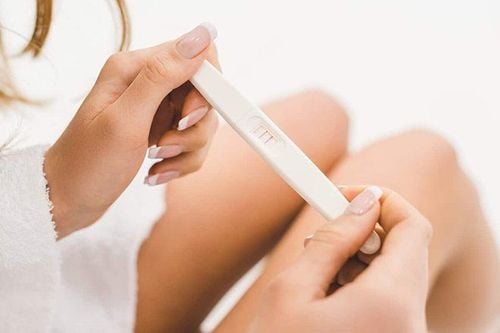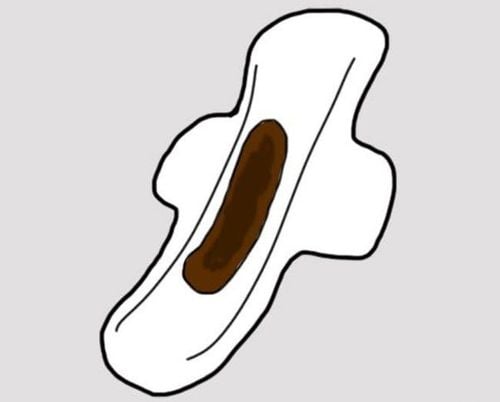The pregnancy test strip helps women to quickly determine whether they are pregnant or not. The mechanism of the test is to detect the presence of the hormone hCG. However, women need to know how many days late their period should be before using the test to get the most accurate result.
1. How many days late can a period be to indicate pregnancy?
The process of conception is closely related to a woman's menstrual delay. When the egg is fertilized, the uterine lining thickens to support the embryo, rather than shedding as it typically would during a regular menstrual cycle. This leads to the phenomenon of a missed period, also known as amenorrhea. Based on each person's menstrual cycle, we can calculate the duration of the delay to determine whether or not a woman is having a baby.
"How many days late is pregnancy?" is a common question many women have. In reality, if intercourse occurs during ovulation without contraception, the result can typically be confirmed 2 weeks later (for those with regular menstrual cycles). If the next period is delayed by about 3 days, the likelihood of pregnancy is high.
Depending on how long the period is delayed, different methods of confirmation can be used. The most common methods today are using a pregnancy test strip and a blood test.
2. How many days late can you use a pregnancy test?
The process of conception occurs within 24 hours after unprotected intercourse. About 5 to 10 days later, the fertilized egg travels to the uterus and implants there, then the embryo begins to grow. The process of conception starts even before you notice any pregnancy symptoms.
A pregnancy test strip is a tool that helps you quickly and accurately determine whether you are pregnant. The mechanism of the test is designed to detect the presence of the hormone hCG. This hormone is secreted by the placenta and can be found in the urine of pregnant women.
To determine "How many days late you should use a pregnancy test," time is needed for the hCG levels in the urine to rise. When the concentration of this hormone increases, the pregnancy test can accurately determine if you are pregnant. In cases where intercourse occurs on ovulation day, it usually takes about 9 to 10 days after intercourse for the pregnancy test to provide an accurate result.

3. How to Read Pregnancy Test Results
In addition to knowing how late your period should be before taking a pregnancy test, it's important to understand how to interpret the results after using a test strip. Below are common result scenarios that may indicate pregnancy:
- The test shows two dark lines: This result indicates that the woman is pregnant. She should visit a healthcare facility for confirmation, monitoring, and care as instructed by a doctor.
- The test shows one dark line and one faint line (or two faint lines): This unclear result may be due to testing too early, when the hCG hormone level in the body has not yet reached a detectable threshold. In this case, it is recommended to check the quality of the test strip or retake the test after a few days.
4. How many days later can you take a blood test?
This method can accurately and quickly determine whether you are pregnant. Once the egg is fertilized and implants, the hormone hCG is not only present in the urine but also appears in the blood. Therefore, about 6 days after the egg implants, a blood test can determine if you are pregnant.
The hCG levels gradually increase until the 14th to 16th week of pregnancy, then decrease. The highest level occurs around the 14th week (calculated from the last menstrual period). Pregnant women between the 13th and 16th weeks can have hCG levels as high as 200,000 IU/L. By conducting qualitative and quantitative hCG tests in the blood and urine, it is possible to confirm pregnancy.
In case of pregnancy, special attention is required, as the first trimester is the most sensitive period throughout the pregnancy. To ensure the health of both mother and baby, it is important to:
- Understand the early signs of pregnancy, gestational poisoning, and bleeding during pregnancy.
- Have the first prenatal check-up in a timely manner, ensuring it is done properly and thoroughly, avoiding both too early and too late visits.
- Screen for fetal abnormalities at the 12th week to detect dangerous fetal conditions that can be intervened early.
- Differentiate between normal vaginal bleeding and pathological vaginal bleeding to intervene and protect the pregnancy on time.
- Screen for thyroid disorders during the first trimester of pregnancy to avoid dangerous risks before and during childbirth.
5. How Many Days Late Is Considered Normal for a Period?
A normal menstrual cycle typically lasts between 28 and 32 days, and a delay of 1–2 days is considered normal. However, if menstruation has not occurred after 35 days, it is considered a late period. If pregnancy is not the cause, this condition should be examined early to avoid potential impacts on reproductive health, as late periods can be a sign of certain medical conditions or syndromes that may lead to infertility in women.
The article above has helped clarify the question, “How late should your period be before taking a pregnancy test?” and highlighted important notes for obtaining accurate results. If the result is unclear or if there are any unusual symptoms, women should seek medical consultation and testing for a more accurate diagnosis.
To arrange an appointment, please call HOTLINE or make your reservation directly HERE. You may also download the MyVinmec app to schedule appointments faster and manage your reservations more conveniently.
To arrange an appointment, please call HOTLINE or make your reservation directly HERE. You may also download the MyVinmec app to schedule appointments faster and manage your reservations more conveniently.








